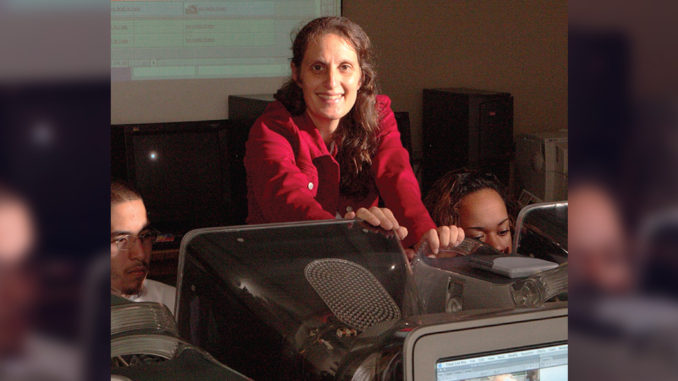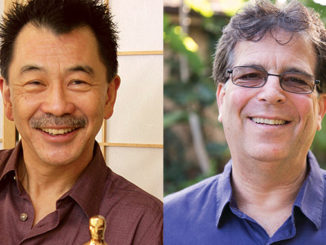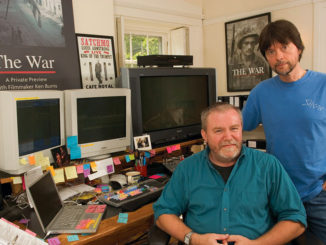
by Laura Almo
When I began film school in 1996, you might say it was a different world: PDR (pre-digital revolution). We were still shooting on Hi-8 and Beta, Final Cut Pro was barely in its infancy, and when we weren’t cutting film or linear 3/4”, we were editing on the Avid. Hi-8 was advanced technology, Mini-DV was on the horizon but by no means easily accessible or commonplace. And HD? Well, a film student like me was not in that league. I felt privileged to be able to get my hands on a piece of equipment, knowing that the cameras and editing systems were expensive tools of the trade that weren’t necessarily easy to come by.
I was in the graduate program in Documentary Film Production at Stanford University, where my first film was a three-minute, black-and-white, non-sync film. And when I say film I mean actual celluloid. We were permitted to shoot four 100-foot rolls of black-and-white reversal film and that was it. From the beginning, we learned about shooting ratios, and at somewhere around $15 a roll, plus the cost of developing, there was no way we were going to be allowed to shoot and shoot and shoot our first time out. This was a genuine introduction to the art of filmmaking and the “craft” of discipline. The assignment taught me the joys of experimenting with sound and the influence that both audio and music could have on a film.
It was the second film assignment, a seven-minute color video shot on Hi-8, that really hooked me on editing. I was doing a profile of Lolly Font, a 63-year-old woman who ran a yoga studio in Palo Alto, California. I had dutifully gone through the motions of conducting a sit-down interview with her, shooting B-roll during a yoga class, filming some abstract, artistic shots of arms, legs and bodies, and then taking the production outside to capture some nature shots in the bucolic, lush hills surrounding Stanford.
But it wasn’t until I sat down with my footage that I truly learned about the art of editing.
Late one night, I began transcribing the interview. Admittedly, I did it as an organizational tactic, but also as a way to put off the really hard work of finding my story and beginning to edit. Transcribing is tedious, laborious even. It’s hard on the neck and shoulders and it is very time consuming. But when I got into what psychologist Mihaly Csikszentimihaly calls “Flow”–– where you become so engrossed by the activity being performed that it’s as if you and the activity are one––there was a “one-ness” with what I was doing. While in this state, I heard the interview in a completely different way––clearly. I was able to pick out the parts that were really the essence of my subject. Would I have found this had I not sat there writing down every word, rewinding the audiocassette until I had it just right? I can’t answer that for sure, but what I did find was the meaning of sitting with the footage and distilling its essence; making sense of this person, reaching directly to the core of her being, and finding a way to accurately portray her in the film.
Yes, an editor must be computer savvy but there is a huge difference between an editor and a computer operator… Pushing buttons will get you a cut, but becoming a storyteller with compassion, empathy and an eye for detail will transform you into an editor.
It was at this time that I was reading acclaimed editor Walter Murch’s In the Blink of an Eye. The timing couldn’t have been any better. I was reading about “the decisive moment,” a term coined by French photographer Henri Cartier-Bresson. In film terminology, Murch described it as “a representative frame that distills the essence of a thousand frames that make up the shot in question.” He was describing a shot; I was thinking about it in terms of finding simplicity and the genuine meaning of my subject matter. Nevertheless, it was this moment that really helped me experience the true joy of editing and distilling my story down to its very essence.
This project was challenging enough because I had to make some difficult editorial decisions. I loved a lot more of the interview than I could possibly use and I had to figure out what I would cut. There was also the problem that some of my B-roll was on the amateur side––shaky, short and poorly lit. As a result, I had to pore over every single shot and figure out where and how to utilize the usable shots. Even though I knew the concept of cutting on action, I wasn’t well-versed in how to do it, so it was difficult to put a sequence together showing the yoga class. I found that with limited hands-on editing experience, my intellectual knowledge far outweighed my capabilities and savvy as an editor. I frequently felt that there was a better way to edit something…if only I knew how to achieve it.
I wanted to end the film outside of the yoga studio. It was there––in nature––that my subject felt at peace. Yoga was a path toward that place, but nature was the destination. I had to figure out a way to get there visually. When I found a shot that was a tilt up a yoga student’s leg, I cut it together with a tilt going up a tree trunk and ended on a steady shot of a magnificent redwood tree. I knew this was how I would get back outdoors. Voila! I had discovered a magical transition that worked!
The challenges and ultimate simplicity of this film showed me just how gratifying editing could be. Subsequent projects presented far more complex and hair-splitting challenges, but not before I had experienced the magic and found my “bliss” in editing.
This is what I carry with me when I teach.
It is often the case that documentaries are made in the cutting room, so why not set my students up with early challenges that will only strengthen their skills if and when they choose to undertake narrative films?
Teaching Editing
A decade later, I am teaching Editing at El Camino College in Torrance, California. I try to convey the sense of magic that is felt when a cut works, a transition solves an unfathomable problem or a music cue creates just the right mood. I punctuate this with the nitty-gritty “how to,” albeit tedious, skills and duties of an editor.
Technology has changed dramatically since I was in film school and many of my students have never shot or edited anything but Mini-DV. Their reference point is Adobe Premiere vs. Final Cut Pro. Some students have worked on an Avid, but even this is becoming rare. They may have heard of the Steenbeck and the Moviola but few have actually worked on, let alone seen, one.
I like to talk about what it was like “back in the days of film editing” to give them a real sense of the craft––how it was so much more difficult and time-consuming to experiment with different cuts (after all, it wasn’t just a matter of duplicating a project and pushing a button, but physically taking apart one cut to try something different that might or might not work). When it didn’t work, there wasn’t an “undo” button to revert back to the favored cut. And sync problems could take days to fix.
Now that we’re firmly in the digital age, I recognize that we’re playing by a new set of rules. Yes, an editor must be computer savvy but there is a huge difference between an editor and a computer operator. It is from this vantage point that I teach editing. Learning Final Cut Pro, the Avid or Adobe Premiere is not all there is to learning to edit. Pushing buttons will get you a cut, but becoming a storyteller with compassion, empathy and an eye for detail will transform you into an editor.
I teach my class with as many real-world assignments as I can I borrow from my own experience and combine it with the wisdom of the masters––(and American Cinema Editors members)–– Murch, Dede Allen and Thelma Schoonmaker, to name just a few.
As I put the syllabus together, I think about what helped me the most when I was in film school and what I felt was lacking.
Getting to know the footage is basic. This includes logging footage (and the ability to accurately identify different types of shots, such as the WS, MS, CU, ECU, etc…).
Screening footage more than once and taking good notes figure prominently into good editing skills, and I emphasize this with each and every project. The old-fashioned paper edit, replete with index cards and the concept of actually moving ideas around in physical space rather than simply cutting and pasting on the computer is key. I also emphasize the importance (and downright necessity) of walking away––that is taking a short break––from a project to gain perspective.
As part of the course syllabus, each successive editing assignment becomes progressively more complex. All, however, incorporate technical and conceptual aspects of editing. The first assignments focus primarily on getting comfortable (this is not to say advanced) with Final Cut Pro. I emphasize project organization: starting a new project, capturing footage, creating bins, organizing clips in bins, making sub-clips and saving a project (often and in the right location)!
Many students at El Camino College come to my editing class with a little knowledge of Final Cut Pro. Most, however, do not have the organizational tools to manage a project. They tell me this is one of the most useful skills. I tell them it will always be an asset. I’ve seen it in my own projects, especially the large ones, but good organization begins with the smallest project.
When my students have basic organizational skills down, I move on to storytelling skills. I’ve chosen to emphasize non-fiction projects, including a PSA, a promo piece and a documentary. Not only is documentary my passion, but Schoonmaker even weighs in on this, explaining that her years of trying to carve a story out of a mass of documentary footage (Woodstock, 1970) helped her with projects that were heavily improvisational, such as Raging Bull (1980) and Goodfellas (1990).
I teach my class with as many real-world assignments as I can I borrow from my own experience and combine it with the wisdom of the masters
It is often the case that documentaries are made in the cutting room, so why not set my students up with early challenges that will only strengthen their skills if and when they choose to undertake narrative films? This is also a great way to teach them about solving tricky editorial problems without the use and overuse of fades, dissolves and transitions. With Final Cut Pro, it is so easy to go into the effects bin and try out a dissolve, but rarely is that an efficient use of precious editing time or an intelligent solution.
I like to provide reading material that illustrates how and why transitions would be used, as well as why overusing transitions is a sign of an amateur. It’s all well and good that my students read and absorb the articles, but the real satisfaction comes when students see examples of a poorly used transition in their own work. For example, I had one student who stealthily used FCP’s “page turn” effect in his film after being instructed to use “straight cuts only.” “Oh, it’s just a placeholder,” he said during the rough cut review. But there’s nothing like seeing it with the entire class as witness to bring the message home that there must be a motivated reason for fades, dissolves and especially all those tacky transitions.
I try to simulate real-world conditions and assignments as much as possible. This means that professionalism and arriving to class on time are on par with completing assignments. I assign reading that is relevant and engaging. I never forget that I also was a student with too much to read, too little time and tempted to skim rather than comprehend an article. The bellwether is that if I can do the reading and stay focused when I’m tired and have had a long day, I can expect my students to do the same.
Voila! I had discovered a magical transition that worked! Subsequent projects presented far more complex and hair-splitting challenges, but not before I had experienced the magic and found my “bliss” in editing.
I don’t like to waste their time, or mine. I teach my students how to log footage and do a paper edit as a practical necessity, because I know these skills will be infinitely useful. When it comes to tests and papers, I emphasize assignments that will make them think rather than regurgitate answers with rote responses. I would prefer that they can explain a jump cut or crossing the axis in their own words, and why this is relevant to their own work, rather than giving me a word-for-word definition from their film glossary.
My students’ final exam is to write a cover letter to the organization, network, cable channel or film project of their choice. This is as much for their benefit as it is for mine. It teaches job search skills and serves as a template for a letter that can be modified for real-world positions. It also gives me a good idea of what they actually learned in the class––which assignments were the most valuable and which assignments need refinement or should be dropped altogether.
As I put the syllabus together, I think about what helped me the most when I was in film school and what I felt was lacking. I highlight the nuts and bolts of the craft and demystify the ins-and-outs of the industry. I will be the first to acknowledge that I benefit from my students’ insights, be it from discussions concerning technology and aesthetics, conversation and debate about current films, or class assignments. I fine-tune my own skills while sharpening my students’ proficiency and expertise.
Teaching editing enables me to be the mentor I always wanted and never had.






